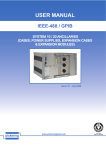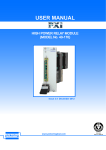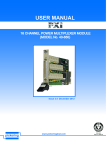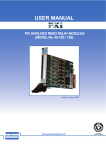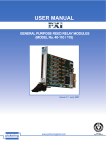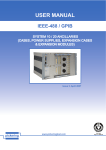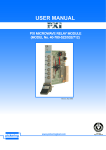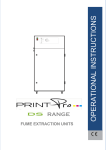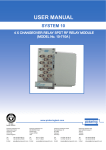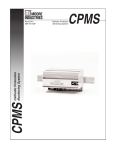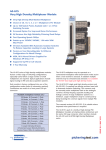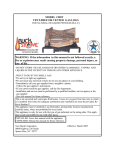Download User Manual - Artisan Technology Group
Transcript
pickering User Manual 14-Slot PXI Chassis (Model No. 40-914) Issue 5.4 January 2014 pickeringtest.com pickering 14-SLOT PXI CHASSIS 40-914 Page 1 pickering © COPYRIGHT (2014) PICKERING INTERFACES. ALL RIGHTS RESERVED. No part of this publication may be reproduced, transmitted, transcribed, translated or stored in any form, or by any means without the written permission of Pickering Interfaces. Technical details contained within this publication are subject to change without notice. ISO 9001 Reg No. FM38792 Page ii 14-SLOT PXI CHASSIS 40-914 pickering TECHNICAL SUPPORT For Technical Support please contact Pickering Interfaces either by phone, fax, the website or via e-mail. WARRANTY All products manufactured by Pickering Interfaces are warranted against defective materials and workmanship for a period of two years, excluding PXI chassis and LXI chassis, from the date of delivery to the original purchaser. Any product found to be defective within this period will, at the discretion of Pickering Interfaces be repaired or replaced. Products serviced and repaired outside of the warranty period are warranted for ninety days. Extended warranty and service are available. Please contact Pickering Interfaces by phone, fax, the website or via e-mail. ENVIRONMENTAL POLICY Pickering Interfaces operates under an environmental management system similar to ISO 14001. Pickering Interfaces strives to fulfil all relevant environmental laws and regulations and reduce wastes and releases to the environment. Pickering Interfaces aims to design and operate products in a way that protects the environment and the health and safety of its employees, customers and the public. Pickering Interfaces endeavours to develop and manufacture products that can be produced, distributed, used and recycled, or disposed of, in a safe and environmentally friendly manner. Observe the Electrical Hazard Warning detailed in Section 5. Observe the Electrostatic Sensitive Device Caution detailed in Section 5. Worldwide Technical Support and Product Information http://www.pickeringtest.com Pickering Interfaces Headquarters Stephenson Road Clacton-on-Sea CO15 4NL United Kingdom Tel: +44 (0)1255-687900 Fax: +44 (0)1255-425349 E-Mail: [email protected] Pickering Interfaces Inc. 2900 Northwest Vine Street Grants Pass Oregon 97526 USA Pickering Interfaces GmbH Johann-Karg-Straße 30 D-85540 Haar-Salmdorf Germany Pickering Interfaces AB Karl Nordströmsväg 31 432 53 Varberg Sweden Tel: +1 541 471 0700 Fax: +1 541 471 8828 E-Mail: [email protected] Tel: +49 89 125 953 160 Fax: +49 89 125 953 189 E-Mail: [email protected] Tel: +46 340-69 06 69 Fax: +46 340-69 06 68 E-Mail: [email protected] Pickering Interfaces Inc. (East Coast Regional Office) 67 South Bedford Street, Suite 400W Burlington, Massachusetts 01803 USA Pickering Interfaces s.r.o. Smetanova 525 ˇ Trinec 739 61 Czech Republic Pickering Interfaces SARL 6 Rue De La Mare Blanche 77186 Noisiel Marne Le Vallee France Tel: +1 781 229 5882 Fax: +1 781 272 0558 E-mail: [email protected] Tel: +42 0558 339 168 Fax: +42 0558 340 888 E-mail: [email protected] Tel +33 1 60 53 55 50 Fax +33 1 60 53 55 99 email [email protected] 14-SLOT PXI CHASSIS 40-914 Page iii pickering THIS PAGE INTENTIONALLY BLANK Page iv 14-SLOT PXI CHASSIS 40-914 pickering CONTENTS Copyright Statement..............................................................ii Technical Support and Warranty..........................................iii Contents (this page)...............................................................v Section 1 Technical Specification.......................................................1.1 Section 2 Technical Description.........................................................2.1 Backplane..................................................................2.1 Power Supply............................................................2.3 Mechanical.................................................................2.4 Section 3 Installation............................................................................3.1 Getting Started..........................................................3.1 Installing The Chassis..............................................3.3 Fan Speed Setting.....................................................3.4 Connecting The Saftey Ground...............................3.5 Installing PXI Modules..............................................3.5 Installing & Identifying a PXI Chassis in NI MAX.....3.7 Section 4 Maintenance.........................................................................4.1 Section 5 Warnings And Cautions......................................................5.1 14-SLOT PXI CHASSIS 40-914 Page v pickering THIS PAGE INTENTIONALLY BLANK Page vi 14-SLOT PXI CHASSIS 40-914 SECTION 1 - TECHNICAL SPECIFICATION pickering SECTION 1 - TECHNICAL SPECIFICATION 40-914 High Performance 14 Slot PXI Mainframe ● High Performance 14 Slot PXI/ cPCI Backplane ● Dual Modular Supplies ● Compact Benchtop Footprint ● Low Profile 4U Rugged Design ● Voltage Monitoring Included ● Power Supplies Hot Swap Capable ● Low Audible Operating Noise Versions Available ● 3 Year Warranty Pickering Interfaces Model 40-914 PXI Chassis features the industry-standard, fourteen-slot PXI/cPCI backplane integrated into a 3U cardcage. The 41-914 includes all the features and performance required by the PXI standard and supports a control interface or embedded controller and up to 13 additional 3U peripheral modules. The 40-914 chassis can be controlled from a PC using Pickering Interfaces PCI to PXI Control Interface 41-921. For applications such as office or laboratory environments where acoustic noise levels are critical, the chassis can be supplied with either lower speed fans or with fans whose speed can be set to full, medium or slow with easily accessed internal switches. ISSUE 5.1 JAN 2014 The 40-914 chassis is provided with two removable modular power supplies on the left of the chassis. Power supply voltage and fault monitoring is through front panel LEDs. Replacement power supply modules are available from Pickering as spare parts. Four 56cfm fans (total 224cfm) ensure maximum cooling with minimal noise. Quick filter media and fan maintanence is provided by a removable fan tray. 14-SLOT PXI CHASSIS 40-914 Page 1.1 pickeringtest.com SECTION 1 - TECHNICAL SPECIFICATION Backplane pickering Monitoring Incorporates all the features of the PXI specification. The backplane is 64-bit with PXI triggers, Star Trigger, Local Bus & internal PXI clock. Power Supply Interface: Front panel LED indicators. Functions: Power supply DC output voltage verification (90% nominal). Indicators: Green LEDs for Power OK, Red LED for Fault. AC input: 90 - 264VAC, universal input, Line Fuse protected. Physical Parameters Cooling: Convection, cardcage with forced air. Cardcage: Front loading 3U x 160mm, flush, 14 slots, IEEE 1101.1, 1101.10 and 1101.11 Dimensions: 257.8mm (10.53”D) 442.2mm (17.41”W) with out rack mount flanges. Supplied with two 175W power supplies (Type 59102) with the following total capacity: DC Outputs Dual Supplies +3.3V 50A +5V 50A +12V 6A -12V 2A Note: Combined 3.3V and 5V current, 54Amps Maximum. Power Factor: 0.99 (typical). Efficiency: 70% (typical). 177mm (6.97”H) Weight: 8.5kg (18.6 lbs.), Safety & CE Compliance All modules are fully CE compliant and meet applicable EU directives: Low-voltage safety EN61010-1:2001, EMC Immunity EN61000-6-1:2001, Emissions EN55011:1998. Cooling Airflow: 482.6mm (19.00”W) with rack mount flanges. Bottom intake, side/rear exhaust, pressurized cardcage. Product Order Codes 14 Slot, 3U, 350W, PXI Chassis Chassis with 3 speed fans 40-914-001 40-914-101 (4) 56cfm fans (224cfm total). Chassis with low noise fans 40-914-201 Acoustic Noise: 56.5 - 58.2dB @ 1meter (A weighting) PCI to PXI Control Interface Kit 41-921-001-KIT Air Filter: Bottom accessible, washable media. For full details of our fast PCI to PXI control Interface see the 41-921 data sheet. Fans: Low Acoustic Noise Versions: Available with selectable fan speed (3 speeds set by internal switches). Available with low noise fans. Operating Conditions (operating with specified airflow) 0°C to +55°C Up to 95% non-condensing 5000m Storage and Transport Conditions Storage Temperature: Humidity: Altitude: Replacement Power Supply Module 44-910-003 Mating Connectors & Cabling Operating/Storage Conditions Operating Temperature: Humidity: Altitude: Spare Parts -20°C to +70°C Up to 95% non-condensing 15000m Please refer to the Pickering Interfaces “Connection Solutions” catalog for a full list of connector/ cabling options, including drawings, photos and specifications. This is available in either print or as a download. Alternatively our web site has dynamically linked connector/cabling options, including pricing, for all Pickering PXI modules. Latest Details Please refer to our Web Site for Latest Product Details. www.pickeringtest.com Page 1.2 pickeringtest.com 14-SLOT PXI CHASSIS 40-914 © Copyright (2014) Pickering Interfaces. All Rights Reserved Pickering Interfaces maintains a commitment to continuous product development, consequently we reserve the right to vary from the description given in this data sheet. Bus Design: SECTION 2 - TECHNICAL DESCRIPTION pickering SECTION 2 - TECHNICAL DESCRIPTION BACKPLANE The 40-914 PXI chassis uses a 14-slot backplane which consists of 1 system slot and 13 peripheral slots (at 33 MHz) with 20.32 mm (0.8 inch) board center-to-center spacing. Key Features: ●● ●● ●● ●● ●● ●● ●● Compliant with PXI specification R2.1. Two ATX sockets and screw terminals for +3.3V, +5V, ±12V DC output connection. 10-layer PCB for accurate impedance control. ATX socket and screw terminals for DC output connection. 64-bit PCI bus on J1 and J2, support N-1 bus-mastering I/O slots (N: Slots). System controller slot is located in slot 1. Trigger controller slot is located in slot 2, providing individual triggers to all other peripherals. Interoperability With CompactPCI The 40-914 backplane is interoperable with PXI-compatible products and standard CompactPCI products. This is an important feature, as many PXI-compatible systems may not require components that do not implement PXI-specific features. For example, you may want to use a standard CompactPCI network interface card in a PXI chassis. The signals on the P1 connector of the backplane meet the requirements of the CompactPCI specification for both the peripheral and system modules. The PXI-specific signals are located on P2 and are only found on the signals that are reserved or not used in the CompactPCI 64-bit specification. Therefore, all modules that meet the requirements of the CompactPCI 64-bit specification will function in the 40-914. System Controller Slot The System Controller slot is located in Slot 1 of the chassis as defined by the PXI specification. It has three controller expansion slots, which are used for system controller modules that are wider than one slot. As defined in the PXI specification, these slots allow the controller to expand to the left to prevent the controller from using up peripheral slots. Star Trigger Slot The Star Trigger (ST) slot is located at Slot 2. This slot has a dedicated trigger line between each peripheral slot (see Figure 2.1). This slot is intended for modules with Star Trigger functionality that can provide individual triggers to all other peripherals. However, if you do not require advanced trigger functionality, you can install any standard peripheral module into this slot. Peripheral Slots - there are seven peripheral slots including the Star Trigger controller slot. The Star Trigger Slot can also accept an external standard to replace the chassis reference clock, PXI_CLK10 supplied by the chassis. Local Bus The PXI backplane’s local bus is a daisy-chained bus that connects each peripheral slot with its adjacent peripheral slots to the left and right, as shown in Figure 2.1. For example, a given peripheral slot’s right local bus connects to the adjacent slot’s left local bus and so on. Each local bus is 13 lines wide and can pass analog signals between cards or provide a high-speed side-band communication path that does not affect the PXI bandwidth. Local Bus signals may range from high-speed TTL signals to analog signals as high as 42V. Initialization software keys adjacent boards to prohibit the use of incompatible boards. This software uses the configuration information specific to each peripheral board to evaluate compatibility. This method is a flexible way to define local bus functionality that is not limited by hardware keying. Trigger Bus The 40-914 includes the 8 trigger bus lines defined in the PXI standard to interconnect the system and peripheral slots. 14-SLOT PXI CHASSIS 40-914 Page 2.1 SECTION 2 - TECHNICAL DESCRIPTION pickering PCI Arbitration and Clock Signals Figure 2.1 - PXI Local Bus and Star Trigger Routing Page 2.2 14-SLOT PXI CHASSIS 40-914 Local Bus Peripheral Slot - [14] Local Bus Peripheral Slot - [13] Local Bus Peripheral Slot - [4] Local Bus Peripheral Slot - [3] Star Trigger/PeripheralSlot-[2] System Controller Slot - [1] Star Triggers SECTION 2 - TECHNICAL DESCRIPTION pickering POWER SUPPLY The 40-914 uses two hot swappable modular power supplies that have easy access from the front panel. Standard versions are operated from the supply to the chassis which can be in the range of 90V to 260V AC. Optional power supplies are DC operated from 36V to 72V (Option 1) or 18V to 36V (Option 2). The power supply modules provide +5V, +3.3V, +12V and -12V DC to the PXI backplane. When two power supplies are installed (standard configuration), either one is capable of supplying the entire system power should the other one fail (providing the total PXI module load does not exceed the power capability of a single power supply module). Users may insert or remove a redundant power supply from the system without interrupting the system operation (provided the backplane load can be supplied from one power supply module). However, for systems where the chassis is fully populated, it is recommended that the system is powered down prior to changing a power supply. In the event of failure, replacement power supply modules are available as spare parts from Pickering with the order code: 44-910-003. Key Features ●● ●● ●● ●● ●● ●● ●● ●● ●● ●● ●● ●● Eurorack-compatible module design 110/220V AC input, 175W Hot swap with N+1 load sharing Remote sense on main output (+5V) Efficiency 73% Built-in EMI filter Over voltage protection Short circuit protection on all outputs Over temperature protection at 90ºC DIN standard input/output connector Status LEDs indicate power OK and Fault FCC Class B regulations Power Status Indication Status LED Indication Green Input OK Red Power supply FAULT 14-SLOT PXI CHASSIS 40-914 Page 2.3 SECTION 2 - TECHNICAL DESCRIPTION pickering MECHANICAL Figure 2.2 - Mechanical Drawing For The 40-914-001 PXI Chassis Page 2.4 14-SLOT PXI CHASSIS 40-914 SECTION 3 - INSTALLATION & OPERATION pickering SECTION 3 - INSTALLATION AND OPERATION GETTING STARTED Unpacking Carefully remove every item from the shipping container and check the chassis for any damage. Make sure all handles, hardware, and switches are in good condition. If damage appears, please contact Pickering Interfaces for service or replacement. Each PXI chassis contains the following items: ●● This manual (printed or on CD) ●● 40-914 Chassis with Filler panels ●● A power cord (110V/220V alternative) ●● Installation CD (includes electronic manuals and chassis.ini files) Environment The 40-914 chassis uses industrial standard mechanical components and high performance connector technologies to provide an optimized system for rugged applications. Operating Temperature 0~55°C (32~131°F) Storage Temperature -20~70°C (-40~158°F) Relative Humidity (Operating and Storage) 10~95% @ 40°C, non-condensing 5~100Hz: 0.015G²/Hz Packaged Vibration 100~200Hz: -6 dB/Oct 200 Hz: 0.0038 G²/Hz Unpackaged Vibration 5~55~5Hz 0.38mm Peak to Peak Falling Height: 76 cm Drop Test Falling: 1 corner/3 edges/6 faces Acceleration: 10G Shock Test (Operating) Pulse width: 11ms Pulse shape: half sine wave No. of shock: 3 shocks for bottom side 14-SLOT PXI CHASSIS 40-914 Page 3.1 SECTION 3 - INSTALLATION & OPERATION pickering WARNING THIS EQUIPMENT CONTAINS VOLTAGE HAZARDOUS TO LIFE AND SAFETY, AND IS CAPABLE OF INFLICTING PERSONAL INJURY IF CARE IS NOT TAKEN. CAUTION BEFORE UNDERTAKING ANY TROUBLESHOOTING, MAINTENANCE, OR EXPLORATORY PROCEDURE, CAREFULLY READ THE WARNING AND CAUTION NOTICES IN SECTION 5. ●● Chassis Grounding - The 40-914 chassis requires a connection from the factory wire safety ground to the 40-914 chassis ground. The earth safety ground must be connected during use of this equipment to minimize shock hazards. Refer to the “Connecting Safety Ground” section at the end of this chapter for instructions on connecting safety ground. ●● Live Circuits - Personnel must not remove protective covers when operating or servicing the 40-914. Adjustments and service to internal components must be undertaken by qualified service technicians. During servicing of this product, the main power connector must be disconnected. Dangerous voltages may be present under certain conditions; use extreme caution. ●● Explosive Atmosphere - Do not operate the chassis in conditions where flammable gases are present. Under such conditions this equipment is unsafe and may ignite the gases or gas fumes present. ●● Parts Replacement - Please service this equipment only with parts that are exact replacements, both electrically and mechanically. Contact Pickering Interfaces for replacement part information. Installation of parts with those that are not direct replacements may cause harm to personnel operating the hardware. Furthermore, damage or fire may occur if replacement parts are unsuitable. ●● Modification - Do not modify any part of the hardware from its original condition. Unsuitable modifications may result in operation faults or safety hazards. Page 3.2 14-SLOT PXI CHASSIS 40-914 SECTION 3 - INSTALLATION & OPERATION pickering INSTALLING THE CHASSIS This section includes information on siting the chassis for the most effective cooling, as well as setting the fan speed and connecting the saftey ground. Site Considerations The 40-914 is designed to operate on a bench or in an instrument rack. Determine how you want to use your 40914 and follow the appropriate installation instructions. Apertures in the rear and along both sides of the chassis facilitate power supply and module cooling. As shown in Figure 2-2, air enters through filters and fan inlets located in the lower rear of the chassis and exits through the upper sections on both sides and through the rear. Cooling Considerations The area above and below the chassis should be kept clear to ensure the inlet and exhaust air paths are not obstructed. The user should allow at least 0.5 U separation between the top and bottom of the chassis and the other instruments in the rack. If the chassis is placed above an instrument that vents hot air from its top cover then a mechanical separator, such as a tray, should be used to stop the chassis from taking hot air into the chassis The side and rear air exhausts should be kept clear of obstructions Ensure that all unused slots in the chassis have filler panels installed, as required by the PXI standard, to ensure the correct internal air flow. Ensure the air filter on the bottom of the chassis is correctly installed after cleaning. Figure 3.1 - Minimum air gap required at the top and bottom of the 40-914 chassis. 14-SLOT PXI CHASSIS 40-914 Page 3.3 SECTION 3 - INSTALLATION & OPERATION pickering FAN SPEED SETTING (40-914-101) The 40-914-101 version of the chassis is fitted with 4 fans that can each be set to one of three speed settings. For office and laboratory use it is recommended that the medium speed setting is used. For use in a rack where higher temperatures may be experienced and fan noise is less of an issue, the speed can be set to high. The low speed setting should be used with caution in applications where there is low module power dissipation and no risk of the chassis overheating. The following procedure describes the sequence for changing the fan speed. Note: Figures 3.2 and 3.3 show an 8-slot chassis with 3 fans, the procedure for a 14-slot chassis with 4 fans is basically the same. 1. Turn off power to the chassis and remove all cabling. 2. Place the chassis on its back (with PXI slots facing upwards) to gain access to the underside. 3. Remove the 5 crosshead screws securing the fan tray to the underside of the chassis - as shown in Figure 3.2. Figure 3.2 - Locations of the 5 screws securing the fan tray to the underside of the chassis 4. Carefully lower the fan tray by pivoting it on its lower edge, taking care not to strain the wiring to the fan assemblies. 5. Locate the 2 fan controller boards mounted on the side of two of the fans - as shown in Figure 3.3. Figure 3.3 - Locations of the 2 fan controller boards mounted on the side of the fans 6. Referring to the legend on the fan controller boards, set the speed of each fan by removing the link from its current position and refitting it to the required setting (each board controls two fans). The legend on the controller board is shown in Figure 3.4. 7. Refit the fan tray and secure with the 5 crosshead screws. 8. Return the chassis to its normal orientation, refit all cabling and apply power. Page 3.4 Figure 3.4 - Legend on the fan controller board with the speed setting links highlighted 14-SLOT PXI CHASSIS 40-914 SECTION 3 - INSTALLATION & OPERATION pickering CONNECTING THE SAFETY GROUND WARNING THE 40-914 CHASSIS IS DESIGNED WITH A THREE-POSITION IEC CONNECTOR THAT CONNECTS THE GROUND LINE TO THE CHASSIS GROUND. TO MINIMIZE SHOCK HAZARD, MAKE SURE YOUR ELECTRICAL POWER OUTLET HAS AN APPROPRIATE EARTH SAFETY GROUND THAT IS CONNECTED WHENEVER YOU POWER UP THE CHASSIS. IF YOUR POWER OUTLET DOES NOT HAVE AN APPROPRIATE GROUND CONNECTION, YOU MUST CONNECT THE FACTORY WIRE SAFETY GROUND TO THE CHASSIS. TO CONNECT THE SAFETY GROUND, COMPLETE THE FOLLOWING STEPS: 1.Connect a 16 AWG (1.3 mm) wire to a chassis grounding screw using a toothed grounding lug. The wire must have green insulation with a yellow stripe or must be non-insulated (bare). 2. Attach the opposite end of the wire to permanent earth ground using toothed washers or a toothed lug. INSTALLING PXI MODULES CAUTION WARNING - DANGER OF ELECTRIC SHOCK BEFORE REMOVING A MODULE FROM THE CHASSIS ENSURE THAT ALL CONNECTIONS TO THE MODULE ARE REMOVED Electrostatic discharge can damage the components on the module. To avoid such damage in handling the board, touch the anti-static bag to a metal part of the chassis before removing the board from the bag. Ensure that there will be adequate ventilation for the module when fitted into the chassis. The module should be installed in accordance with the following procedure: 1. Do not attempt to install, or remove, modules with the user connection attached. The UUT should be electrically and mechanically disconnected from the chassis. 2. Handle all PXI modules as you would any other static sensitive device. Ensure that the bag containing the PXI module is at the same voltage as the chassis by touching both at the same time. Store any modules being removed in a static protection bag. 3. Ensure that the system is turned OFF but still connected to mains so that it remains grounded. 4. Choose an appropriate slot in the rack. 5. Remove the blanking plate for the chosen slot. 6. Ensure that the injector/ejector handle is in its downward position. Align the module with the module guides on the top and bottom of the slot. 14-SLOT PXI CHASSIS 40-914 Page 3.5 SECTION 3 - INSTALLATION & OPERATION pickering CAUTION Do not raise the injector/ejector handle whilst inserting the module. The module will not insert properly unless the handle is in its downward position. 7. Hold the handle whilst slowly sliding the module into the module guides until the handle catches on the injector/ejector rail (refer to Figure 3.5). 8. Raise the injector/ejector handle until the module firmly seats into the backplane. The front panel of the module should be flush with the front panel of the chassis. 9. Screw the front panel of the module to the front panel mounting rail. 10. Power up the chassis and wait for the green Ready light. Figure 3.5 - Installing a module into the PXI Chassis Page 3.6 14-SLOT PXI CHASSIS 40-914 SECTION 3 - INSTALLATION & OPERATION pickering INSTALLING AND IDENTIFYING A PICKERING PXI CHASSIS IN NI MAX Any non-NI PXI chassis will not be identified by manufacturer and model in MAX unless the appropriate files are added to the controller system. This lack of identification is not usually a problem, the chassis will appear as (Unidentified) in the MAX list, but this should not affect its performance in any way. In order to make MAX fully identify a Pickering chassis, follow these instructions: If you are obtaining the configuration ini files from the Pickering “Software Installation” disk then ignore steps 1, 2 and 6a, alternatively if you are downloading these files ignore step 6b. 1.Copy the required .ini file from the download location to your PC using the following link: http://www.pickeringtest.info/downloads/drivers/Chassis/ 2.Copy the files to any convenient location on your PC, for example to the Desktop. 3.Launch MAX and expand: My System, Devices and Interfaces, PXI System. 4.The Pickering chassis will appear in the list followed by the word (Unidentified). 5.Right click on the entry and select: Identify As. 6a.Select the entry appropriate for the chassis, if it is not present, then select “Other” and browse to the location of the file downloaded above. 6b.Select the entry appropriate for the chassis, if it is not present, then select “Other” and browse to the location of your chassis .ini file on the Pickering “Software Installation” Disk, in the folder: “\Drivers_PXI\PXI Chassis Identification”. 7.Change the file filter to “All Files (*.*)” and select the appropriate ini file. 8.The chassis should now be correctly identifed in MAX. 14-SLOT PXI CHASSIS 40-914 Page 3.7 SECTION 3 - INSTALLATION & OPERATION THIS PAGE INTENTIONALLY BLANK Page 3.8 14-SLOT PXI CHASSIS 40-914 pickering SECTION 5 - MAINTENANCE pickering SECTION 4 - MAINTENANCE MAINTENANCE This chapter covers the following maintenance procedure information. The maintenance information is intended for qualified service personnel. If you are not experienced in maintenance service, please contact Pickering Interfaces for further help. ●● Recommened Service Intervals ●● Preparation ●● Cleaning Recommended Service Intervals ●● Clean the air filter every 6 months or more frequently if the mainframe is operated in a dusty environment. ●● Clean dust and dirt from the exterior (and interior) of the mainframe as needed. Routine cleaning will increase the reliability of the mainframe. Preparation Before undertaking maintenance, please read the following information carefully: Static Damage Many components within the chassis are susceptible to static discharge damage. Therefore when maintaining the chassis, we suggest you always do so in a static-free environment. Please follow the standard handling procedures for static-sensitive devices and wear a grounded wrist strap or equivalent while servicing the chassis. Parts Replacement Please service this equipment with electrically and mechanically certified parts. Parts that are not certified and not genuine may cause harm to the service personnel. Furthermore, damage or fire may occur if replacement parts are unfit. Modification Please keep the chassis in its original condition. Inappropriate modifications may cause safety problems. Explosive Atmosphere When servicing the chassis, please keep it away from conditions where flammable gas is present. Under such condition this equipment is unsafe and may ignite gas or fumes. Cleaning The following explains the general cleaning procedures for the 40-908 8-Slot Chassis. Please contact Pickering Interfaces for further help and questions. NOTE: Before cleaning the chassis, please power-off the chassis and disconnect the power cord. 14-SLOT PXI CHASSIS 40-914 Page 5.1 SECTION 5 - MAINTENANCE pickering Interior Cleaning Use a dry, low-velocity stream of air to clean the chassis interior, then use a soft-bristle brush to clean the components. If you want to use a liquid cleaning agent, use a 75% isopropyl alcohol solution and rinse with deionized water. Exterior Cleaning Use a dry lint-free cloth or a soft-bristle brush to clean the exterior surfaces of the chassis. If there is any dirt, wipe with a cloth moistened in a mild soap solution, then wipe with a cloth moistened with clean water to remove the soap residue. Do not use abrasive cleaning agents on any part of the chassis. Cleaning the Fan Filters Remove the fan filters from the bottom of the chassis. Clean the filters by washing them in a mild soap solution and rinse with clean water and allow to dry before reinstalling them back to the chassis. Alternatively, clean the filters by vacuuming or blowing air through them. CAUTION AVOID GETTING MOISTURE INSIDE THE CHASSIS DURING EXTERIOR CLEANING. DO NOT USE TOO MUCH MOISTURE TO DAMPEN CLEANING CLOTHS. DO NOT WASH THE FRONT-OR-REAR PANEL CONNECTORS OR SWITCHES. WHILE CLEANING THE CHASSIS, PLEASE COVER THESE COMPONENTS. DO NOT USE CHEMICAL CLEANING AGENTS THAT CONTAIN BENZENE, TOLUENE, XYLENE, ACETONE, OR SIMILAR SOLVENTS. THESE CLEANING AGENTS MAY DAMAGE THE COMPONENTS. Page 5.2 14-SLOT PXI CHASSIS 40-914 pickering SECTION 5 - WARNINGS & CAUTIONS SECTION 5 - WARNINGS & CAUTIONS WARNING – HAZARDOUS ENVIRONMENTS This product is not specifically designed for use in hazardous environments, for example in explosive atmospheres. If the product is to be used in hazardous environments we recommend that the user ensures suitable protective measures are taken. WARNING - DANGER OF ELECTRIC SHOCK THIS MODULE MAY CONTAIN HAZARDOUS VOLTAGES. BEFORE REMOVING THE MODULE FROM THE RACK REMOVE ALL SUPPLIES. CAUTION – Handling of Electrostatic-Sensitive Semiconductor Devices Certain semiconductor devices used in this equipment are liable to damage due to static voltage. Observe the following precautions when handling these devices in their unterminated state, or sub-units containing these devices: 1. Persons removing sub-units from an equipment using these devices must be earthed by a wrist strap and a resistor at the point provided on the equipment. 2. Soldering irons used during the repair operations must be low voltage types with earthed tips and isolated from the mains voltage by a double insulated transformer. 3. Outer clothing worn must be unable to generate static charges. 4. Printed Circuit Boards (PCBs) fitted with these devices must be stored and transported in anti-static bags. 14-SLOT PXI CHASSIS 40-914 Page 5.1 pickering THIS PAGE INTENTIONALLY BLANK Page 5.2 14-SLOT PXI CHASSIS 40-914

























